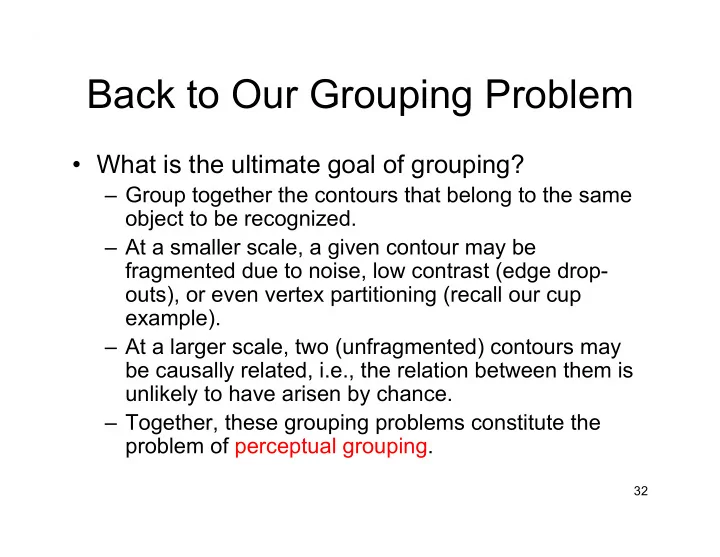

Back to Our Grouping Problem • What is the ultimate goal of grouping? – Group together the contours that belong to the same object to be recognized. – At a smaller scale, a given contour may be fragmented due to noise, low contrast (edge drop- outs), or even vertex partitioning (recall our cup example). – At a larger scale, two (unfragmented) contours may be causally related, i.e., the relation between them is unlikely to have arisen by chance. – Together, these grouping problems constitute the problem of perceptual grouping. 32
How Can Vision be Possible? (P. Sinha and E. H. Adelson, ICCV, 1993) • An image on the retina is infinitely ambiguous. • How does the human visual system manage this ambiguity? 33
Perceptual Grouping • The shape of the world, both animate and inanimate, is very regular. Why? • The Gestaltists observed that the human vision system exploits these regularities in order to manage the infinite ambiguity. • How do 3-D regularities in the world map to 2-D regularities in an image of the world? 34
Gestalt Laws of Perceptual Grouping 35
What do You See (in 3D)? 36
How Good Are You? (Easy) 37 (A. Maßmann, S. Posch, G. Sagerer, and D. Schlüter, ICIP, 1997)
Harder 38
Hardest 39
A Computational Model • How do we translate perceptual grouping into a computational model that we can apply to our contours? • Will adopt the model of David Lowe (1985). • Will focus only on three grouping rules: proximity, collinearity, and parallelism. 40
Proximity-Based Grouping • Significance a function of closest distance and smaller line length. 2 ⎛ ⎞ l s ⎜ ⎟ μ = ⎜ ⎟ pro g ⎝ ⎠ 41
Collinearity-Based Grouping • Significance a function of closest distance, smaller line length, and angle between lines. 2 l μ = θ s col + s ( l g ) s 42
Parallelism-Based Grouping • Significance a function of separation (perpendicular distance from midpoint of smaller line to longer line), both line lengths, and angle between lines. 2 l μ = s par θ sl L 43
Parallelism vs. Collinearity • The semantics of collinearity- and parallelism-based grouping are different. • Under what conditions should we consider such grouping? • If segments overlap, we’ll compute parallelism potential; if not, compute collinearity potential. • How do we compute overlap? if (a1cos θ ∈ [b1,b2]) or (a2cos θ ∈ [b1,b2]) then group parallel else a2 group collinear a1 θ b2 b1 44
Algorithm: Perceptual_Grouping Input: S, the set of contours (connected pixel chains) 1) For all pairs of image segments in S: a) compute μ pro b) depending on which segments in the pair overlap, compute μ par or μ col 2) Order the groups in decreasing order by category 3) Group pairs for which μ pro > τ pro , or μ par < τ par , or μ col < τ col . Demonstration 45
Do We Really Need to Examine All Pairs? • Only need to consider grouping features that are nearby. Limitations? • Can we use any of our tools to locate nearby contours? • Insert line endpoints into DB and perform a range search (modification of NN- search) to yield nearby endpoints (lines). 46
Recommend
More recommend